Shaken & Stirred: The history of James Bond games
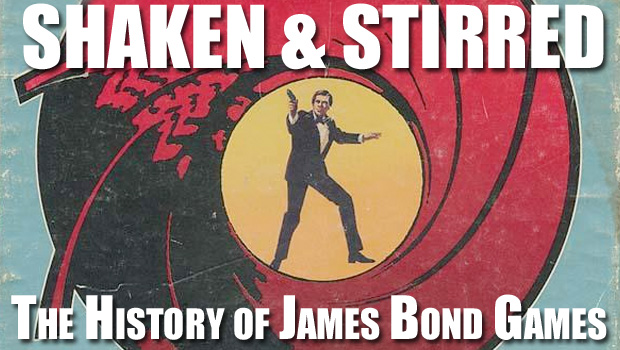
The names Bond
James Bond. You may have heard of him. Originally created in 1953 by British novelist Ian Fleming, Agent 007 has been an entertainment icon ever since, appearing in over 40 novels and short stories, 22 feature films, a handful of television shows, radio broadcasts, comic books, and of course, lots and lots of video games.
With the latest Bond flick, Skyfall, and the latest Bond game, 007 Legends, just around the corner, 007 fever has promptly struck millions of fans worldwide. So, keeping that in mind, its time to take a look back at the virtual adventures of everyones favorite martini-drinking fictional agent, chronicling the good, the bad, and the Bond.
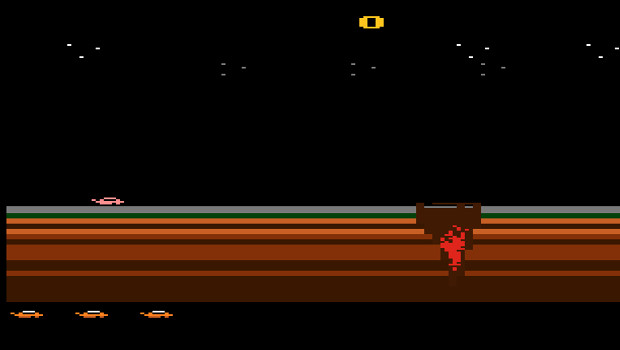
James Bond 007 (1983)
Mr. Bonds gaming debut was a fairly unspectacular side-scroller for the Atari 2600, Atari 5200, Commodore 64, and ColecoVision. Rather than letting players control the agent himself, it put them behind the wheel of Bonds Batmobile-like car, which could leap over obstacles, dodge enemy attacks, and shoot lasers to take down foes. Four missions were included, each of them loosely based on a Bond film: Diamonds Are Forever, Moonraker, For Your Eyes Only, and The Spy Who Loved Me.
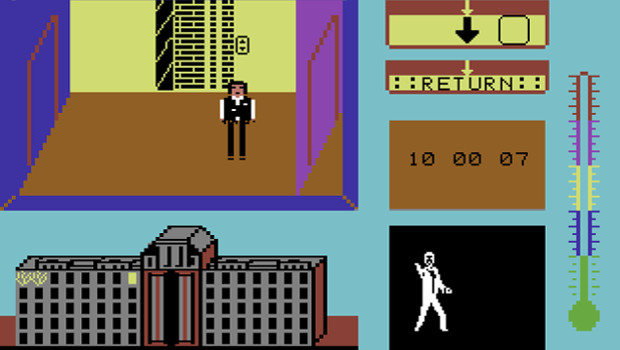
A View to a Kill (1985) and A View to a Kill (1985)
Thats right: There were two separate games based on the 14th entry (and last to star Roger Moore) in the Bond film series. The first was a buggy action game split into three sections, all of them centered on the events of the film, which saw our hero saving California from the villainous Max Zorin. It was the first Bond effort from UK publisher Domark, which would go on to make six Bond games in total. It even featured the iconic movie intro sequence, in which Bond turns and shoots at the camera.
The second A View to a Kill, too, closely followed the movies happenings, only without the fancy cutscenes or graphics. It was a text-based adventure game from Mindscape; pretty much the exact opposite from Domarks title. A follow-up, James Bond 007: Goldfinger, arrived a year later, in 1986.
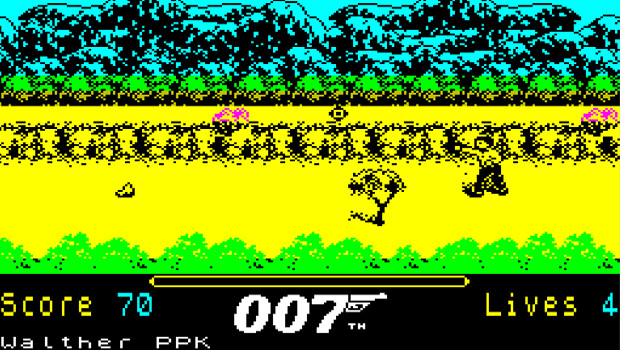
The Living Daylights (1987)
Domarks next movie tie-in came a couple of months after Timothy Daltons Bond debut, and pitted him against the likes of the KGB, nefarious arms dealers, andkiller milkmen. The side-scrolling third-person shooter sported eight levels and less bugs than A View to a Kill, but was still hampered by awkward controls and weak looks. One highlight, however, was its soundtrack, composed by the prolific video game composer David Whittaker.
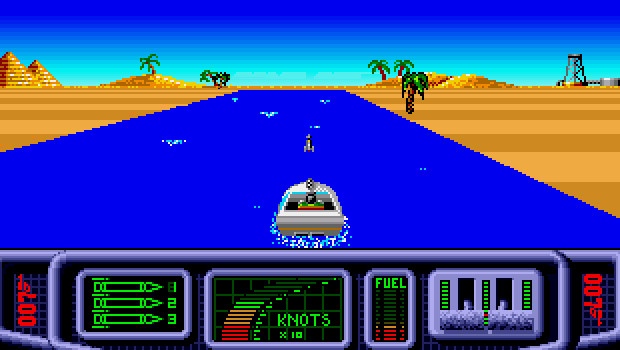
Live and Let Die (1988)
Domark had a stranglehold on the Bond license throughout the mid-to-late 80s, but that didnt stop them from switching things up from the usual action game formula with this 1988 release. Unlike its side-scrolling predecessors, Live and Let Die was a speedboat racing game. Weird, right?
In actuality, Live and Let Die was a re-branding of a game called Aquablast, which was in development at the time but found itself overhauled to (very) loosely fit the Bond name. While it was certainly different, it wasnt all that good, featuring repetitive, shallow missions and almost no resemblance to the actual license.
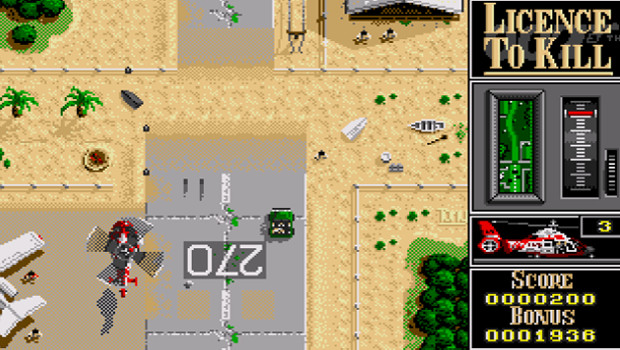
007: License to Kill (1989)
Heres where things started to pick up a bit. Domarks fourth time proved to be the charm, as License to Kill stressed level diversity and tighter controls above all else. You could control Bond on foot, in helicopters, underwater, driving tanker trucks, and even on water-skis, all in the pursuit of the evil drug smuggler Sanchez. It looked, sounded, and played well, and, at the time, set the standard for all future Bond games to come
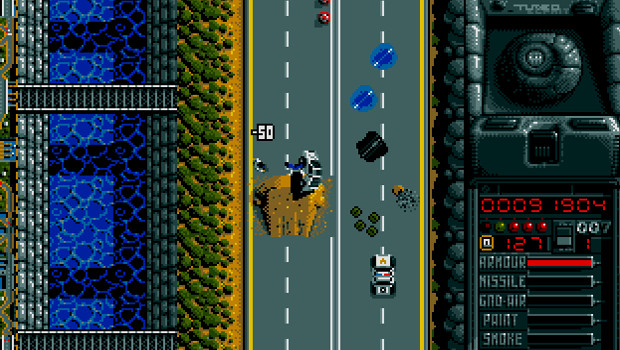
The Spy Who Loved Me (1990)
Domark brought Bond back behind the wheel with this top-down shooter and racing hybrid. Like Live and Let Die before it, The Spy Who Loved Me largely ignored the plot of its film namesake, and suffered from mediocre controls and some seriously frustrating spikes in difficulty. Its graphics, sound, and overall presentation were fine, but the rest of The Spy Who Loved Me was ultimately a disappointment after License to Kills successes a year prior.
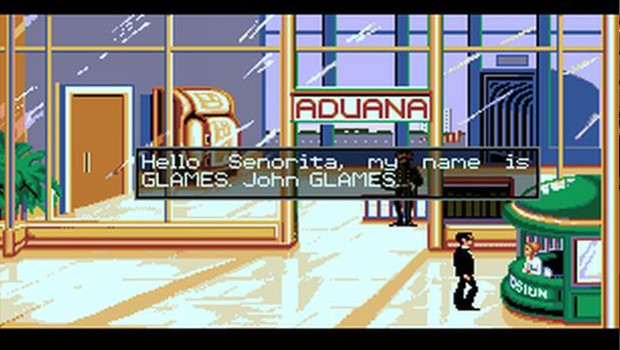
James Bond: The Stealth Affair (1991)
This point-and-click adventure game from French developer Delphine was alright as an experience, but it was more memorable for not actually being a James Bond game in the first place. While The Stealth Affair was re-branded as a Bond title in the United States, European and other markets knew it as Operation Stealth.
There, it featured CIA agent John Glames, a man tasked with locating high-tech stealth planes in Latin America. U.S. markets, meanwhile, received largely the same game, only with John Glames now referred to as James Bond. The recoating led to some odd inconsistencies in the Bond lore, so if youve ever wanted to see 007 take orders from the CIA, instead of the usual MI6, heres your chance.
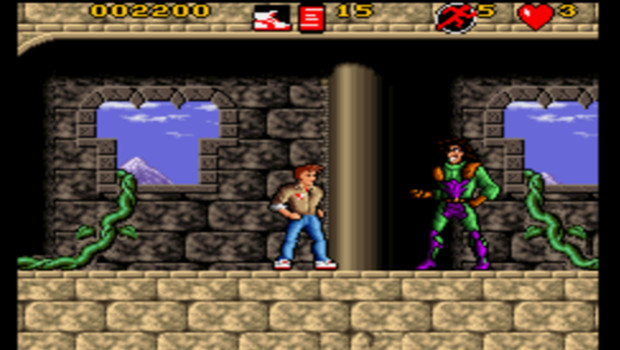
James Bond Jr. (1992)
THQs first and only contribution to the Bond game legacy took its inspiration from the early 90s spin-off cartoon of the same name, and, well, it wasnt quite an adventure worthy of the bigger Bonds name. Two wildly different versions were released for the NES and the SNES, respectively. While the former was a puzzle-platformer, the latter was more of an action title with shoot-em-up elements.
Unfortunately, neither were any good. Both games adhere to the same lackluster and derivative gameplay, and while they each stay faithful to the animated license, theyre not worth getting nostalgic over.
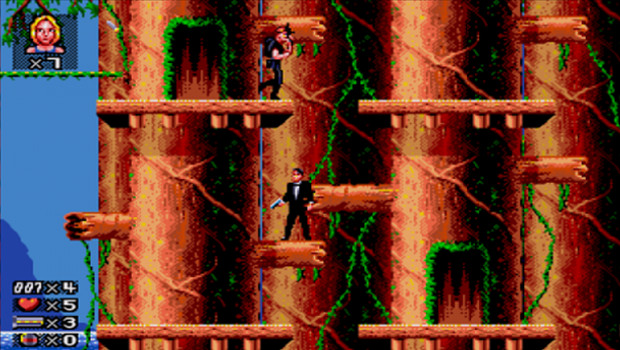
James Bond 007: The Duel (1993)
This Sega exclusive was memorable for a few reasons. For one, it was one of the most influential early Bond titles to not be based on a pre-existing story or film, as Domark decided to compose its own tale--albeit one that saw Bond face off against a variety of past villains--while the agents films were in the midst of a six-year hiatus. It also was the last appearance of Timothy Dalton as Bond, as 1989s License to Kill marked his last film in the franchise. Finally, it was also longtime Bond dev Domarks last title using the license.
Gameplay-wise, The Duel was generally solid, if a tad unexciting. It was yet another third-person action-platformer that looked and controlled well enough (especially on the Genesis version, rather than the Master Systems), but was just too repetitive and straightforward to be considered one of 007s greatest hits.
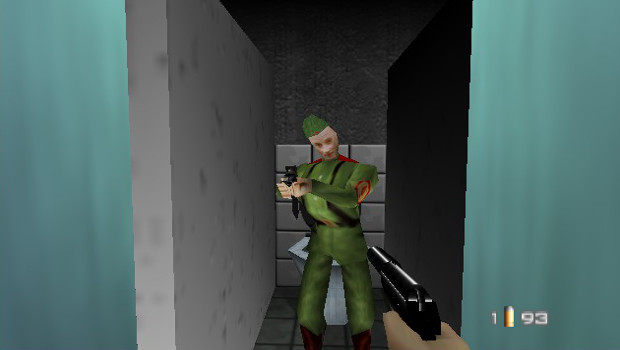
GoldenEye 007 (1997)
What can be said about Rares FPS masterwork that hasnt already been said before? After four years away from the video game scene, Bond came back in a big way, bringing to the Nintendo 64 what may be the most important console shooter ever created. The first title to feature Pierce Brosnan as 007, GoldenEye had a great single-player mode that emphasized stealth alongside combat, varied mission objectives, a wide array of weapons (including one of the first zoomable sniper rifles), and a great overall presentation.
While the solo experience was superb on its own, its Goldeneyes split-screen multiplayer mode that is arguably the most beloved in the genre. Players spent countless nights killing up to three of their friends time and time again, across five different types of deathmatch modes. It set the stage for spiritual successors such as Perfect Dark, arguably laid the foundations for multiplayer juggernauts like Halo and Call of Duty today, and proved that console first-person shooters could thrive alongside their PC brethren.
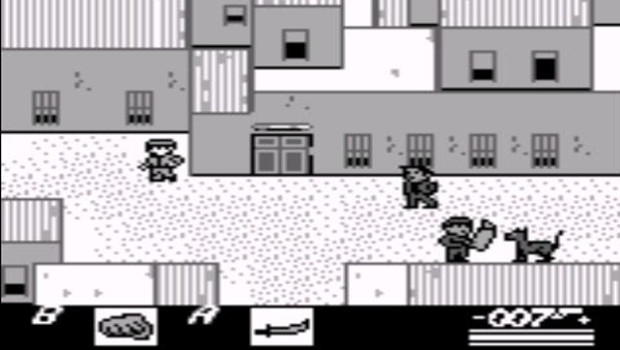
James Bond 007 (1998)
Developer Saffire attempted to capitalize on the revived Bond fever by releasing this Game Boy action-RPG, the agents first ever on a handheld. Rather than following up on Goldeneyes shooter success, though, James Bond 007 played more like an old-school Legend of Zelda, only not quite as engaging. It was a fairly standard RPG, all things considered, only suffering from repetitiveness and the limitations of the aging Game Boy hardware for which it was designed.
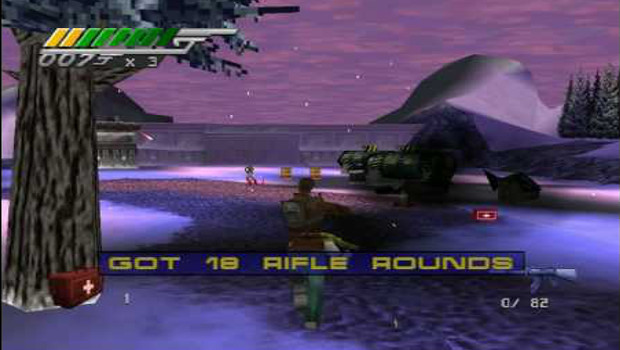
Tomorrow Never Dies (1999)
Bonds return to home consoles came the following year with this PlayStation exclusive. Electronic Arts had captured the licensing rights to James Bond by this point, and the first-person shooting of GoldenEye was soon changed into third-person shooting here. The result was an awkward-controlling piece of standard shooting fare that, while faithful to the Bond name, couldnt quite attain the same magic of its predecessor. Dropping multiplayer from the game certainly didnt help either.
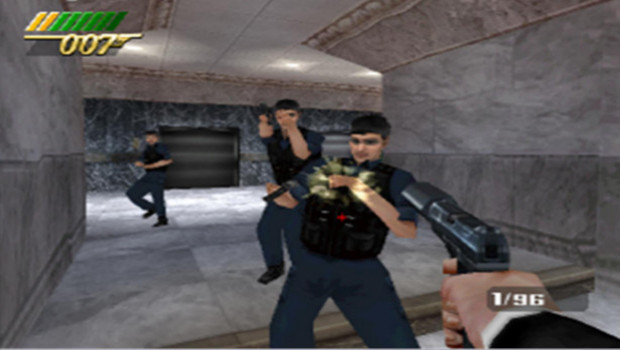
The World Is Not Enough (2000)
After the so-so Tomorrow Never Dies, EA decided to return to GoldenEyes first-person roots with this effort for the Nintendo 64, PlayStation, and Game Boy Color. While the handheld version was by and large terrible, the console editions made a solid enough return to what revived fan interest in Bond in the first place, with good looks and improved controls. PlayStation owners were still denied multiplayer, but N64 players could be take out their buds all over again. It was still great fun, provided that nobody was using Oddjob, of course.
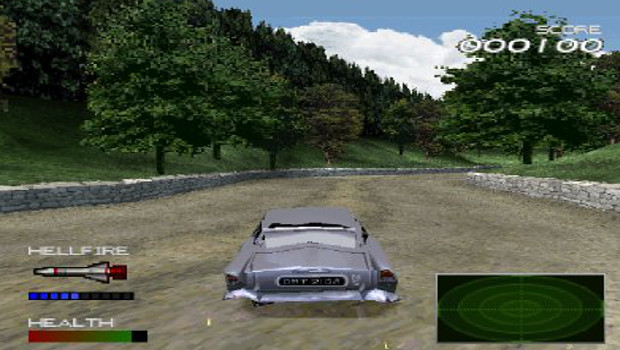
007 Racing (2000)
That same year, Bond was back behind the wheel for this PS1-exclusive action driver, which was inspired by the likes of Twisted Metal and Spy Hunter. It controlled sloppily, featured choppy environments, and, most importantly, made you feel like some psycho in an Aston Martin rather than Bond himself. I suppose you could argue thats all 007 is in the first place, but that doesnt make this one any more enjoyable.
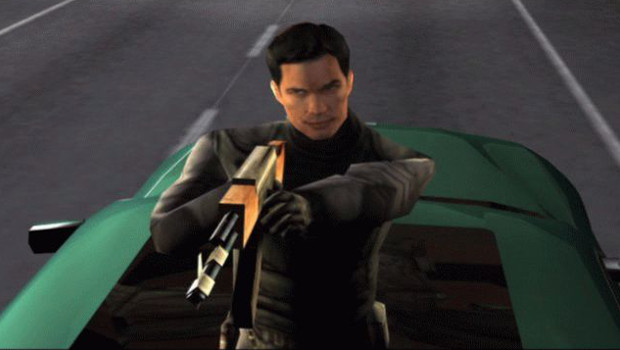
007: Agent Under Fire (2001)
Bond entered the sixth generation of consoles with Agent Under Fire for the PS2, Xbox, and GameCube. It sported an original plotline, introduced driving and rail shooting elements to its traditional FPS gameplay, brought back multiplayer, and naturally wowed players with its looks, since it was one of the earlier next-gen games at the time. Overall, it was a solid debut for Bond on the new set of systems.
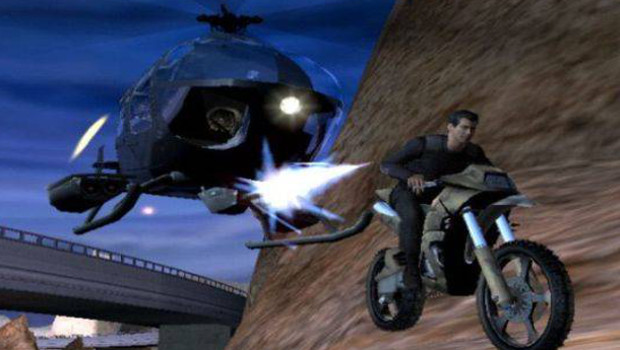
007: Nightfire (2002), 007: Everything or Nothing (2004), and GoldenEye: Rogue Agent (2004)
By this point, EA was releasing Bond games on just about an annual basis, with fans appropriately eating them up in large amounts each time. Some were good, some were bad, but none were really doing anything too different--thus, we lump them together here. Nightfire and Everything or Nothing were both tight, enjoyable shooters that featured increasingly impressive presentations and production values. Rogue Agent, on the other hand, looked fine, but stumbled in its attempts to re-create the successes of GoldenEye all those years ago.
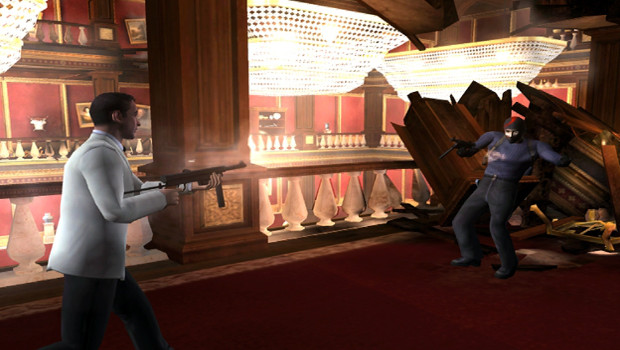
From Russia With Love (2005)
EA decided to turn back the clock with 2005s From Russia With Love, which featured the likeness and voice of legendary actor Sean Connery in a plot based on the 1963 film of the same name. The third-person shooter stayed relatively faithful to its retro source material, but kept things fresh with stunning looks for its time, a load of new gadgets to toy with (jetpacks, anyone?), and the always-solid split-screen multiplayer. It was a little too easy, and its linearity didnt differ much from Everything or Nothing from the year prior, but it was still cool to see the old-school days of Bond receive some love.
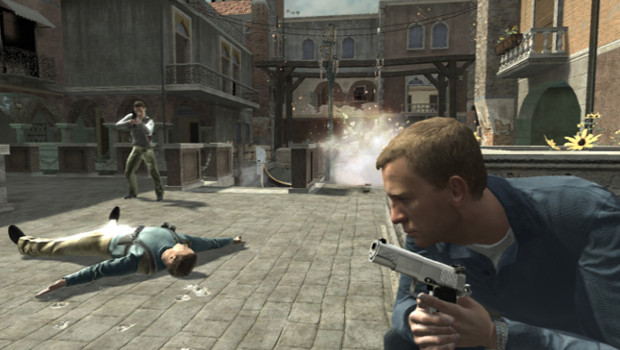
Quantum of Solace (2008)
After failing to get a tie-in game based on 2006s reboot of the Bond film franchise, Casino Royale, onto store shelves, Electronic Arts relinquished their rights to the Bond license, leaving the franchise dormant for the next couple of years. That would soon change after another publishing giant, Activision, got their hands on the famed super spy and put him on current-gen consoles for the first time with Quantum of Solace.
Covering the plots from both the Casino Royale and Quantum of Solace films, this shooter from Black Ops developer Treyarch wasnt quite the glorious return Bond fans had been hoping for. Weak combat, brain dead AI, and design that was simply too derivative of other popular shooters at the time hindered Quantum of Solace from the start, leaving the game more George Lazenby than Daniel Craig. James Bond 007: Blood Stone would follow two years later, and, like Quantum of Solace, it was okay, but not anything special.
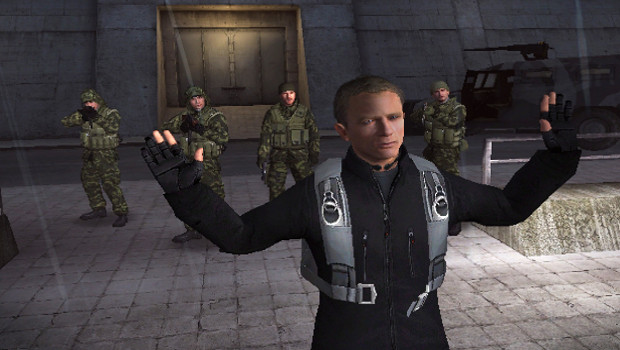
GoldenEye 007 (2010) and GoldenEye 007: Reloaded (2011)
We fittingly end our trip down MI6 memory lane where it began for so many players today: GoldenEye. Announced in tandem with Blood Stone, GoldenEye 007 re-imagined the classic FPS for Wii and Nintendo DS. Pierce Brosnan was replaced by Daniel Craig, the plot was marginally altered, online multiplayer was added, and Bond now used a smartphone to scan objects. It was definitely modern, but still managed to nail that old-school GoldenEye feel for those who never got the chance to experience the magic of the mid-90s. PlayStation 3 and Xbox 360 owners would get in on the action a year later, with the HD remastered GoldenEye 007: Reloaded.
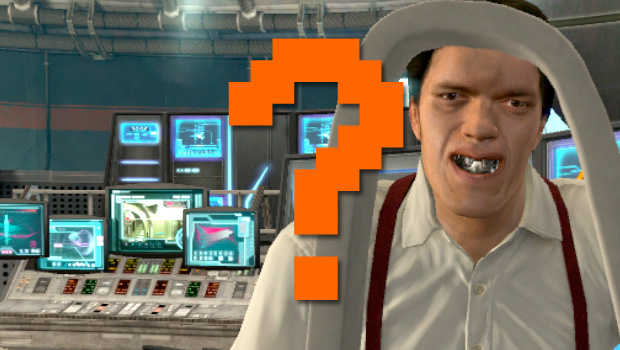
Shaken, not stirred
Well there you have it. As is the case with Bonds films, the games of 007 are highlighted by a few wondrous highs and a few less-than-stellar lows. With 007 Legends dropping next week, the franchise shows no signs of slowing down anytime soon.
So now its your turn to speak up. Whats your favorite Bond game? Can anything compete with the the original GoldenEye? And what would you like to see out of future Bond titles? Let us know in the comments below.
And if you're looking for more looks back to the history of games, check out the history of Pokemon and a history of AO games.


